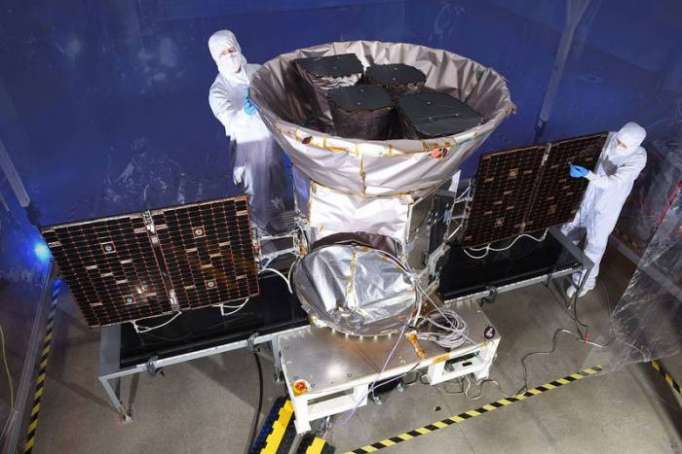Then came a NASA planet-seeker called Kepler, which starting in 2009 began finding intriguing, tell-tale blips around stars other than our sun. Almost everywhere its cameras looked, a new blip was discovered, signifying a rich abundance of “exoplanets.” Kepler’s prodigious planet-spotting—more than 1,000 of the 3,700 discovered to date—was among the first astronomical endeavors to show that the basic pattern of our solar system appears to be common elsewhere.
Now, the successor to Kepler is here. This planet-hunter, a 700-pound spacecraft called the Transiting Exoplanet Survey Satellite (TESS), is scheduled to launch next month and focus on stars nearer and brighter than those analyzed by Kepler. TESS will operate in a unique elliptical orbit, synchronized with the moon, to aim its four sophisticated cameras at roughly 200,000 stars. The mission is to detect brief decreases in brightness caused by a planet cutting across a star. In this orbit, the TESS spacecraft will remain stable for decades.
This type of pioneering astronomy—the study of planets light years away—is designed to help answer one of humanity’s oldest questions: Are we really alone?
The two-year project will examine stars that are no more than 300 light years distant—and as much as 100 times brighter than the ones Kepler detected. This relative proximity will allow for a more detailed analysis of the exoplanets, including such data as their mass, density, composition and the elements that compose their atmospheres.
TESS may very well be the arbiter of which planets we choose to explore first.
A revolution in astronomy has been playing out in the background of our lives. It took humanity 4,000 years to discover eight planets and roughly 20 years to discover 4,000 of them. Sara Seager, who pioneered study of large-exoplanet atmospheres in the late 1990s, likens the search to “a funnel toward finding another Earth.”
“We have this down to a science because of Kepler and many other transit surveys,” Seager, an astrophysicist at Massachusetts Institute of Technology and a leader of the TESS research, said at a NASA news conference Wednesday.
The TESS launch is tentatively scheduled for April 16 aboard a SpaceX Falcon 9 rocket. The craft will undergo two months of orbital positioning and instrument tests before its work begins in earnest. The goal is to assemble a map of 85 percent of the sky and to suss out planets that are roughly 1 to 1.5 times the size of Earth. One central question: Does this size matter when gauging their habitability, as it did here?
Beyond the planet-hunting of Kepler and TESS, the universe may harbor many more planets than we can detect. The current “transit” method of measuring dips in a star’s light correlates only to exoplanets that are in orbits of roughly 90 degrees; other orbital inclinations would not be detectable, Seager said.
TESS is designed to work in tandem with the still-grounded James Webb Space Telescope, NASA’s $8 billion successor to the famed Hubble. Webb has suffered an additional delay, however, and won’t fly before May 2020. When both are operating, those exoplanets that TESS suggests are promising will be sent to the Webb for deeper analysis, NASA officials said.
The TESS “specialty” will be the study of M-class stars, or red dwarfs, the coolest and most common in the galaxy, and not visible to the naked eye. “Ninety percent of the stars we know of in the Milky Way are redder and cooler than is our sun,” said George Ricker Jr., the TESS principal investigator and an MIT senior researcher. “This is exactly the thing that we wanted to do for this mission.”
This artist’s impression shows an imagined view from the surface of one of three planets orbiting an ultra-cool dwarf star just 40 light-years from Earth.European Southern Observatory
This cooler star is also the kind that caused a scientific stir in 2016, when European astronomers announced that they’d detected multiple planets around TRAPPIST-1, a cool dwarf 40 light years from Earth that’s far smaller than our sun. This system is high on the list of TESS targets.
Kepler also helped in a 2011 discovery of a planet orbiting two stars, called Kepler-16b, about 2,000 light years from Earth. It was the first confirmation of a circumbinary planet, or one with two suns. (Kepler-16b also means that Luke Skywalker’s home planet in Star Wars, Tatooine—and its double sunsets—has at least one basis in scientific fact.)
The TESS team is acutely aware of how their work—the beginnings of a classification of other planets—may guide how humankind determines which distant worlds harbor conditions suitable for life.
Ricker said 100 stars within 20 light years of Earth probably have planets. If researchers ever devise a way to travel at 20 percent of the speed of light (about 37,200 miles per second), Ricker estimated, a robot mission to an exoplanet may build upon the work conducted now.
TESS, he said, may well be the arbiter of which planets we choose to explore first.
Bloomberg
More about: NASA
















































